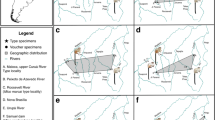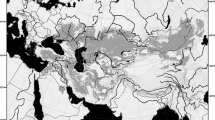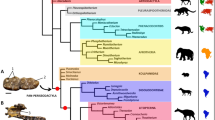Abstract
Consistent with geophysical evidence for the breaking up of Pangaea, it has been hypothesized that Cretaceous vertebrates on progressively isolated landmasses exhibit generally increasing levels of provincialism1,2,3, with distinctly heightened endemism occurring at the beginning of the Late Cretaceous4. The Cretaceous fossil record from the southern supercontinent of Gondwana has been much too poor to test this hypothesis with regards to mammals (Fig. 1 ). Early Cretaceous mammals are known only from isolated sites in Argentina5, Australia6,7, Cameroon8,9 and Morocco10. Apart from several occurrences in South America11, knowledge of Late Cretaceous Gondwanan mammals is limited to a single site in India that previously yielded a few specimens of placental mammals12,13, and a site in Madagascar that previously yielded only one indeterminate tooth fragment14. Here we report the occurrence of a highly specialized and distinctive group of extinct mammals, the Sudamericidae (Gondwanatheria), in the Late Cretaceous of Madagascar and India. These new records comprise the first evidence of gondwanatheres outside South America and the first indication of cosmopolitanism among Late Cretaceous Gondwanan mammals. Antarctica may have served as an important Cretaceous biogeographic link between South America and Indo-Madagascar.

Shaded areas indicate the distribution of subaerially exposed land (adapted from ref. 26); dots indicate mammal localities; stars indicate mammal localities that have yielded gondwanatheres. Madagascar (M), with the Indian subcontinent (I) attached to its current eastern margin, separated from Africa ∼165 Myr ago and attained its current position relative to the mainland ∼124 Myr (refs 23, 25, 29, 30). Strike-slip motion between the Indian subcontinent and Madagascar began ∼135 Myr (ref. 25), as India rifted from Antarctica, but they remained in proximity until ∼88 Myr (ref. 22), several million years before deposition of the Maevarano Formation18. Indo-Madagascar (I-M) and eastern Antarctica were connected until at least ∼120 Myr (ref. 25), and possibly as late as 80 Myr (ref. 26), across the Kerguelen Plateau (KP). The Antarctic Peninsula remained very close to, or maintained contact with, South America in the Late Cretaceous and into the early Tertiary23,24,26.
This is a preview of subscription content, access via your institution
Access options
Subscribe to this journal
Receive 51 print issues and online access
$199.00 per year
only $3.90 per issue
Buy this article
- Purchase on Springer Link
- Instant access to full article PDF
Prices may be subject to local taxes which are calculated during checkout


Similar content being viewed by others
References
Bonaparte, J. New Late Cretaceous mammals from the Los Alamitos Formation, northern Patagonia. Natl Geogr. Res. 6, 63–93 (1990).
Le Loeuff, J. The Campano-Maastrichtian vertebrate faunas from southern Europe and their relationships with other faunas in the world; palaeobiogeographical implicaitons. Cretaceous Res. 12, 93–114 (1991).
Russell, D. A. China and the lost worlds of the dinosaurian era. Hist. Biol. 10, 3–12 (1995).
Sereno, P. C. et al. Predatory dinosaurs from the Sahara and Late Cretaceous faunal differentiation. Science 272, 986–991 (1996).
Bonaparte, J. & Rougier, G. Mamíferos del Cretácico Inferior de Patagonia. Mem. IV Congr. Latinoamėricano de Paleontol., Bolivia 1, 343–359 (1987).
Archer, M., Flannery, T. F., Ritchie, A. & Molnar, R. E. First Mesozoic mammal from Australia—an early Cretaceous monotreme. Nature 318, 363–366 (1985).
Flannery, T. F., Archer, M., Rich, T. H. & Jones, R. Anew family of monotremes from the Cretaceous of Australia. Nature 377, 418–420 (1995).
Jacobs, L. L. et al. Mammal teeth from the Cretaceous of Africa. Nature 336, 158–160 (1988).
Brunet, M. et al. Nouveaux mammifères du Crétacé inférieur du Cameroun, Afrique de l'Quest. C. R. Acad. Sci. 310, 1139–1146 (1990).
Sigogneau-Russell, D., Monbaron, M. & Russell, D. E. Découverte de Mammifères dans le Mésozoïque moyen d'Afrique. C. R. Acad. Sci. 307, 1045–1050 (1988).
Marshall, L. G. & Sempere, T. in Biological Relationships Between Africa and America (ed. Goldblatt, P.) 329–392 (Yale Univ. Press, New Haven, CT, (1993)).
Prasad, G. V. R. & Sahni, A. First Cretaceous mammal from India. Nature 332, 638–640 (1988).
Prasad, G. V. R., Jaeger, J. J., Sahni, A., Gheerbrant, E. & Khajuria, C. K. Eutherian mammals from the Upper Cretaceous (Maastrichtian) Intertrapean beds of Naskal, Andhra Pradesh, India. J. Vert. Paleontol. 14, 260–277 (1994).
Krause, D. W. et al. Late Cretaceous mammals. Nature 368, 298 (1994).
Krause, D. W., Kielan-Jaworowska, Z. & Bonaparte, J. F. Ferugliotherium Bonaparte, the first known multituberculate from South America. J. Vert. Paleontol. 12, 351–376 (1992).
Krause, D. W. & Bonaparte, J. F. Superfamily Gondwanatherioidea: A previously unrecognized radiation of multituberculate mammals in South America. Proc. Natl Acad. Sci. USA 90, 9379–9383 (1993).
Pascual, R., Goin, F. J., Ortiz-Jaureguizar, E., Carlini, A. & Prado, J. L. Ferugliotherium and Sudamerica, Multituberculata and Gondwanatheria: One more evolutionary process occurred in isolation. Ameghiniana 30, 334–335 (1993).
Krause, D. W., Hartman, J. H. & Wells, N. A. in Natural Change and Human Impact in Madagascar (eds Goodman, S. M. & Patterson, B. D. ) 3–43 (Smithsonian Inst. Press, Washington DC, (1997)).
Sigogneau-Russell, D., Bonaparte, J. F., Frank, R. M. & Escribano, V. Ultrasctructure of dental hard tissues of Gondwanatherium and Sudamerica (Mammalia, Gondwanatheria). Lethaia 24, 27–38 (1991).
Grine, F. E., Fosse, G., Krause, D. W. & Jungers, W. L. Analysis of enamel ultrastructure in archaeology: the identification of Ovis aries and Capra hircus dental remains. J. Archaeol. Sci. 13, 579–595 (1986).
Sahni, A. Cretaceous-Paleocene terrestrial faunas of India: Lack of endemism during drifting of the Indian plate. Science 226, 441–443 (1984).
Storey, M. et al. Timing of hot spot-related volcanism and the breakup of Madagascar and India. Science 267, 852–855 (1995).
Lawver, L. A., Gahagan, L. M. & Coffin, M. F. The development of paleoseaways around Antarctica. Antarctic Res. Ser. 56, 7–30 (1992).
Shen, Y. Apaleoisthmus between southern South America and Antarctic Peninsula during Late Cretaceous and Early Tertiary. VII Int. Symp. Antarctic Earth Sciences Abstr. 345, 345 (1995)).
Roeser, H. A., Fritsch, J. & Hinz, K. The development of the crust off Dronning Maud Land, East Antarctica. Geol. Soc. Spec. Publ. 108, 243–264 (1996).
Hay, W. W. et al. in The Evolution of Cretaceous Ocean/Climate Systems (eds Barrera, E. & Johnson, C.) (Geological Society of America, special publication, in the press).
Sampson, S. D., Krause, D. W., Dodson, P. & Forster, C. A. The premaxilla of Magungasaurus (Dinosauria: Theropoda) with implications for Gondwanan paleobiogeography. J. Vert. Paleontol. 16, 601–605 (1996).
Russell, D. A. Isolated dinosaur bones from the Middle Cretaceous of the Tafilalt, Morocco. Bull. Mus. Natl Hist. Nat. Paris 18, 349–402 (1996).
Smith, A. G., Smith, D. G. & Funnell, B. M. Atlas of Mesozoic and Cenozoic Coastlines (Cambridge Univ. Press, (1994)).
Coffin, M. F. & Rabinowitz, P. D. The Mesozoic East African and Madagascan conjugate continental margins. Am. Assoc. Petrol. Geol. Mem. 53, 207–246 (1992).
Acknowledgements
We thank B. Rakotosamimanana, P. Wright, B. Andriamihaja and the Institute for the Conservation of Tropical Environments staff for help with fieldwork in Madagascar; members of the 1995 and 1996 field crews for their efforts; J. Ratsimbazafy for Malagasy translations; C. Forster, R. Fox, Z. Kielan-Jaworowska, R. Presley, T. Rich, G. Rougier and S. Sampson for discussion and/or review of earlier drafts of the manuscript; W. Hay for permission to cite unpublished work; and L. Betti-Nash and M. Stewart for assistance with the figures. This work was funded by the National Science Foundation, the National Geographic Society, and the Deutsche Forschungsgemeinschaft.
Author information
Authors and Affiliations
Corresponding author
Rights and permissions
About this article
Cite this article
Krause, D., Prasad, G., von Koenigswald, W. et al. Cosmopolitanism among Gondwanan Late Cretaceous mammals. Nature 390, 504–507 (1997). https://doi.org/10.1038/37343
Received:
Accepted:
Issue Date:
DOI: https://doi.org/10.1038/37343
This article is cited by
-
The Charm of Paleontology
Journal of the Geological Society of India (2021)
-
Discovery of the oldest South American fossil lizard illustrates the cosmopolitanism of early South American squamates
Communications Biology (2020)
-
Skeleton of a Cretaceous mammal from Madagascar reflects long-term insularity
Nature (2020)
-
New record of a Mesozoic gondwanatherian mammaliaform from Southern Patagonia
The Science of Nature (2020)
Comments
By submitting a comment you agree to abide by our Terms and Community Guidelines. If you find something abusive or that does not comply with our terms or guidelines please flag it as inappropriate.



